Although Paris Boat Show 2021 wasn´t that big highlight in terms of new boats this year, I was happy to being there as now Duesseldorf boat show for January 2022 has been cancelled by most of the brands and makers and in this I at least had the chance to show and see some of our new yachts to potential clients – you may have read my article on the brand new Oceanis 34. 1 of which Paris has been the one and only occasion to see the boat live and in reality. But there also was another boat I was very keen on examining …

Which, of course, is the First 27. Now, the decision by Beneteau and Seascape to come up with their classic Firsts/Seascapes in a new configuration with aluminium rigging, Dacron sails and slightly changed setup was met with mixed feelings, to be honest. “Why buy a Porsche 911 and put in a lean-burn engine?”, not a few of my clients asked. Well, let´s look at this in another way: With the “SE”-variant “Seascape Edition” still offering the “true” experience people look for in a boat like this, the new “Alu”-versions widen the range of possible clients and also make the boats appealing to less freaky sailors. As the yard insists on saying: The First 27 is in no way a downgrade, it is a completely different boat. And here we are, in Paris, having the chance to clarify this. Let´s go …
A fresh Appearance
The new First 27 is of course the smallest of the boats on display and since she has been put on the stand without her fixed keel (which I would have loved to see and show since it´s a very modern appendage as T-keel with a sporty lead bulb) the boat was hovering fairly low over the floor. Nevertheless, many, many people gathered around her and I found it hard to take pictures with a clear view onto the boat.

The First 27 has nearly the same specs as the First 27 SE in terms of data: Same length and width (8 meters and 2.54 meters wide) she weighs in some 300 kilograms more, with 1.700 kilograms in total (empty weight). The ballast has 10 kg more over the swing-keeled SE-variant, so real plus in weight from equipment and changes is 290 kilograms (mainly the Diesel-engine, I´d say, some structural pieces and heavier rigging). That´s a 30% weight increase, which on the first look might seem hefty. On the other hand, 1.300 kg in the SE variant is very low weight and 1.7 tons still okay.
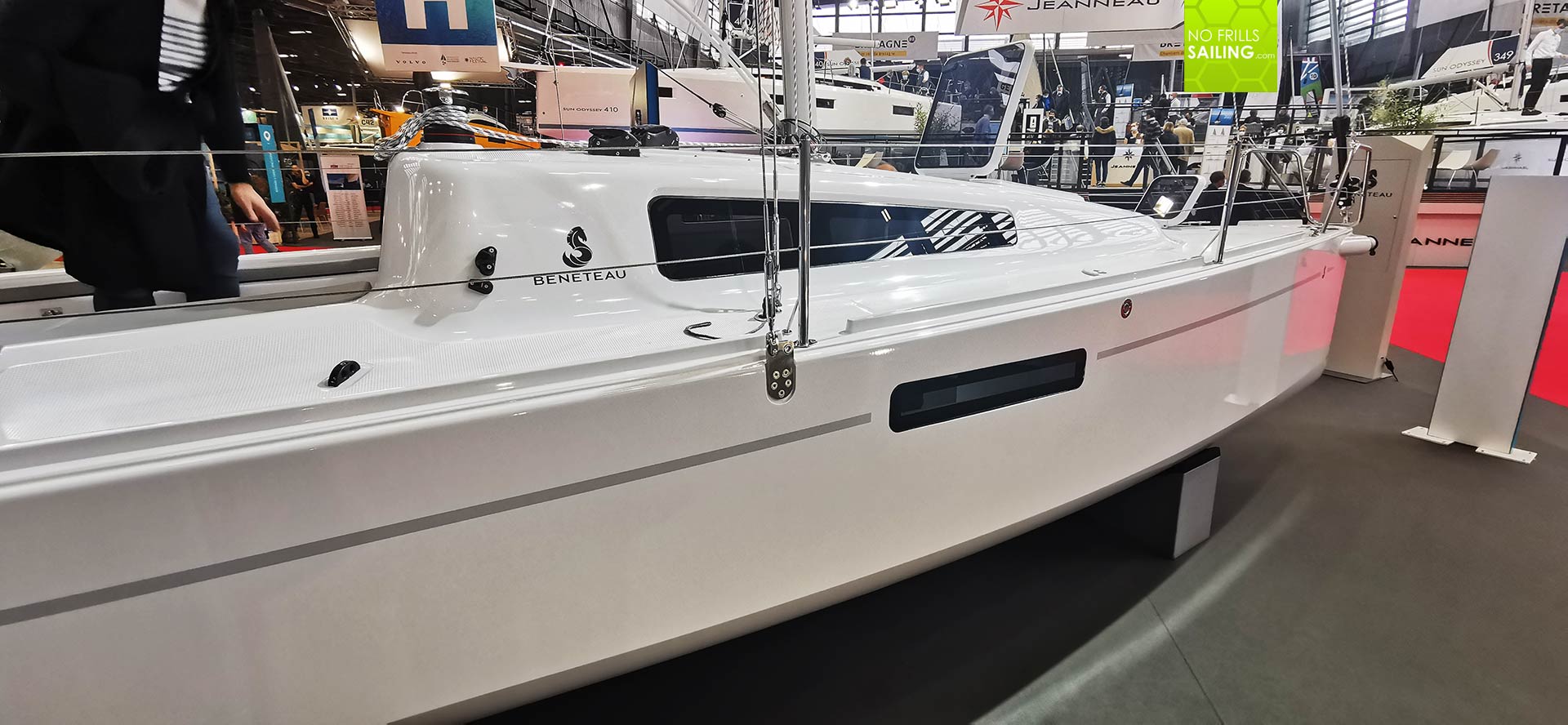
One big change everyone instantly recognizes though from the outside are the big windows in the cabin. Whereas the racing-oriented First 27 SE only has two thin hull windows near the waterline, the First 27 incorporates the big, big windows in the cabin superstructure – same as on the First 24 – which absolutely suffuse the inside with natural light and increase perceived comforts manyfold at once. Very good! To house these large openings, the layup of GRP-mats and lamination (vacuum infusion for First 27 as well!) had been changed, that is why these windows aren´t available with First 27 SE-versions.
The Interior: A pocket cruiser
It was haunted, when I was there: The boat was occupied by people all of the time and I really couldn´t get a single shot of the boat´s interiors without people. So I am sorry, I have to use the yard´s promo-pictures at this stage. Nevertheless, I was able to be inside myself and spot some significant differences which you may see on these PR-pics as well. First thing is, as mentioned above, the light-suffused salon. It really is a booster to the appearance of the whole boat´s inside.

Much more connection to the outside, lighter and friendlier and I am sure that especially when weather gets rough, dark and depressing and the crew will have to stay inside and at anchor, this lighter, friendlier salon with much more natural light will enhance comforts and mood very much! Thanks to the fixed keel on the other hand, the large keel-housing could be taken out so that the salon feels wider and less cramped, especially for the feet of the crew. The floor is still compartmented but even if its just a small detail, the perceived “freedom” is a bit more than on the swing-keeled boat. Other than that, there´s no difference at all to the Seascape-version, still love the crew bags on hinges, clever and so practical.

Vis-à-vis the WC which is the same as on the First 27 SE, one can chose to have a galley. Well, I am indecisive on that one. On the first look it is a practical and logical option you should go for. What you get is a one-flame burner stove and a worktop. Well, you can cook a one-pot-dish here and still do some veggie-chopping or preparing, but is it worth it? The stove is not gimbaled, so offshore cooking will be a mess if not impractical. There is still no sink nor any fresh water-possibilities so no way to do the dishes or even wash hands. Since in the bow section there is no standing height so you´ll have to kneel down to cook. Honestly, I still prefer the gimbaled Jet Boil-solution of my SE-variant: Much more space, big worktop (salon table) and easier to use. Plus: I don´t give up valuable stowage in the from (for Gennaker for example).
Aluminium rigging and other differences
Beneteau and more Seascape yard insist that the Aluminium rigging isn´t a downgrade. I initially wanted to name this article “Alu Sister” but the guys in Slovenia asked me to not treat the First 27 as a downgrade version or even “cheaper” SE, but as a whole new boat. At first I thought this was for PR-reasons but now, that I´ve seen her, I can see the point: Although First 27 SE and 27 chare the same hull by Sam Manuard (and thus same sailing potentials), the 27 is indeed a largely newly conceived boat. Take the rigging.

Mast and boom are constructed by Seldén, which is a new thing for Beneteau. Normally the French incorporate Z-Spars rigging on their yachts. Seascape insisted on Seldén equipment and my impression is a very good one. The rigging has been freshly developed to fit the needs of Manuard´s hull and the data show that there isn´t such significant loss in sails area: 37.3 square meters of upwind sails area for the 27, which is 8.4 square meters less than on the SE-variant. Mainly because the mainsail is not Square Top but Pin Head, losing 6.5 square meters on the main, 2.2 on the Jib. For Gennaker, the SE has 8 Square meters more. That´s still not a lean-mix engine on the 911 …
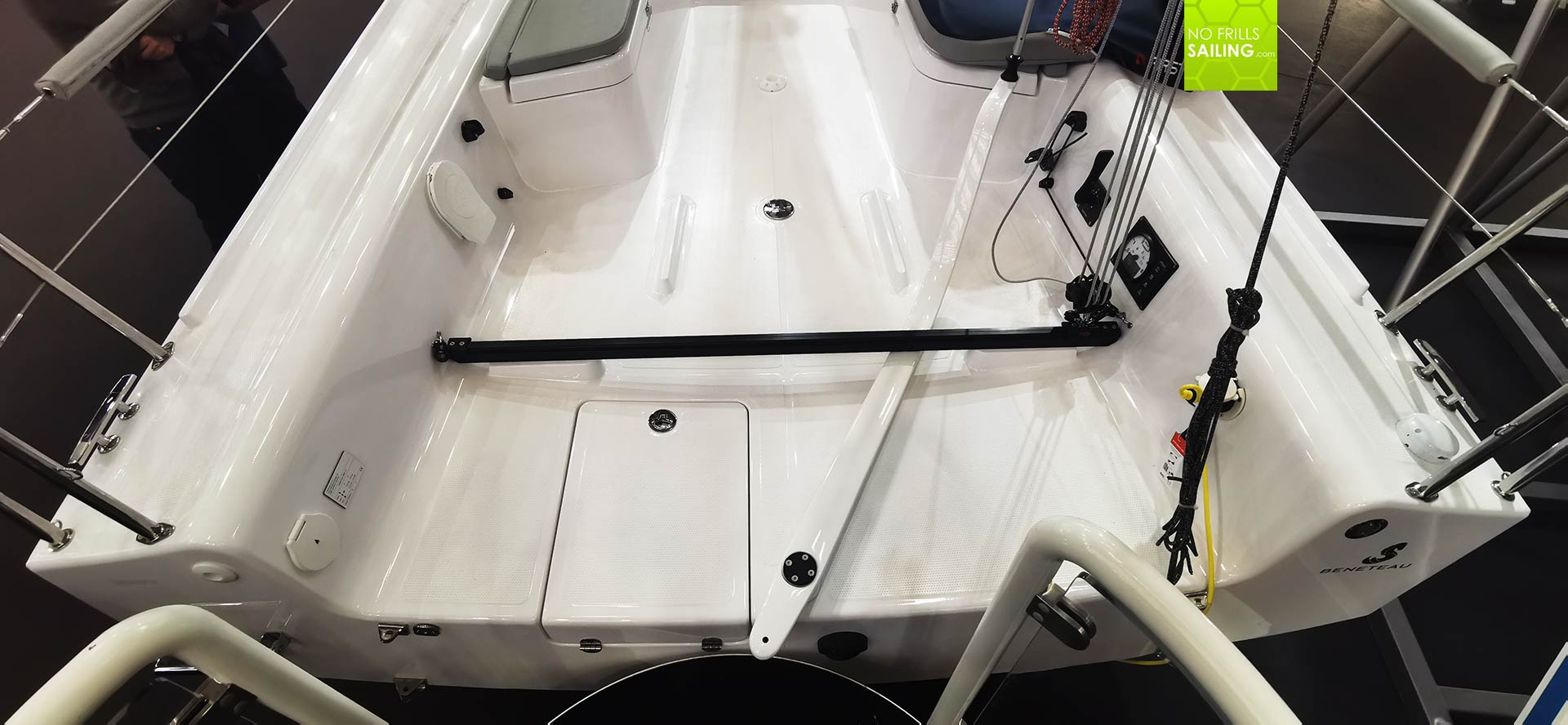
Buyers of the First 27 can choose between ordinary Dacron sails for the start or laminate performance sails by NORTH SAILS. As I have racing sails setup on my boat right now, which I absolutely love and find it amazing (always amazes me!) how perfectly well laminate sails stay up in the wind and can be trimmed to enhance performance, I as well have decided to take the clothing off and replace it by more cruising-friendly garment, namely a Dacron main and a CDX-cruising laminate for the Jib. In this, 27-owners can make a choice here from the start and that is a good thing.
Differences in running rigging compared to First 27 SE
There is even more to the rigging and sails setup. Because the 27 utilizes a Pin Head mainsail it is now possible to attach a back stay. Although I have never had any problems with no back stays on the First 27 SE, the perceived safety especially on running points of sails with high wind speeds and much pressure in the system may be greater on the 27 with a back stay. Also, of course, fore stay trimming upwind is now possible, a plus over the Seascape Edition definitely.
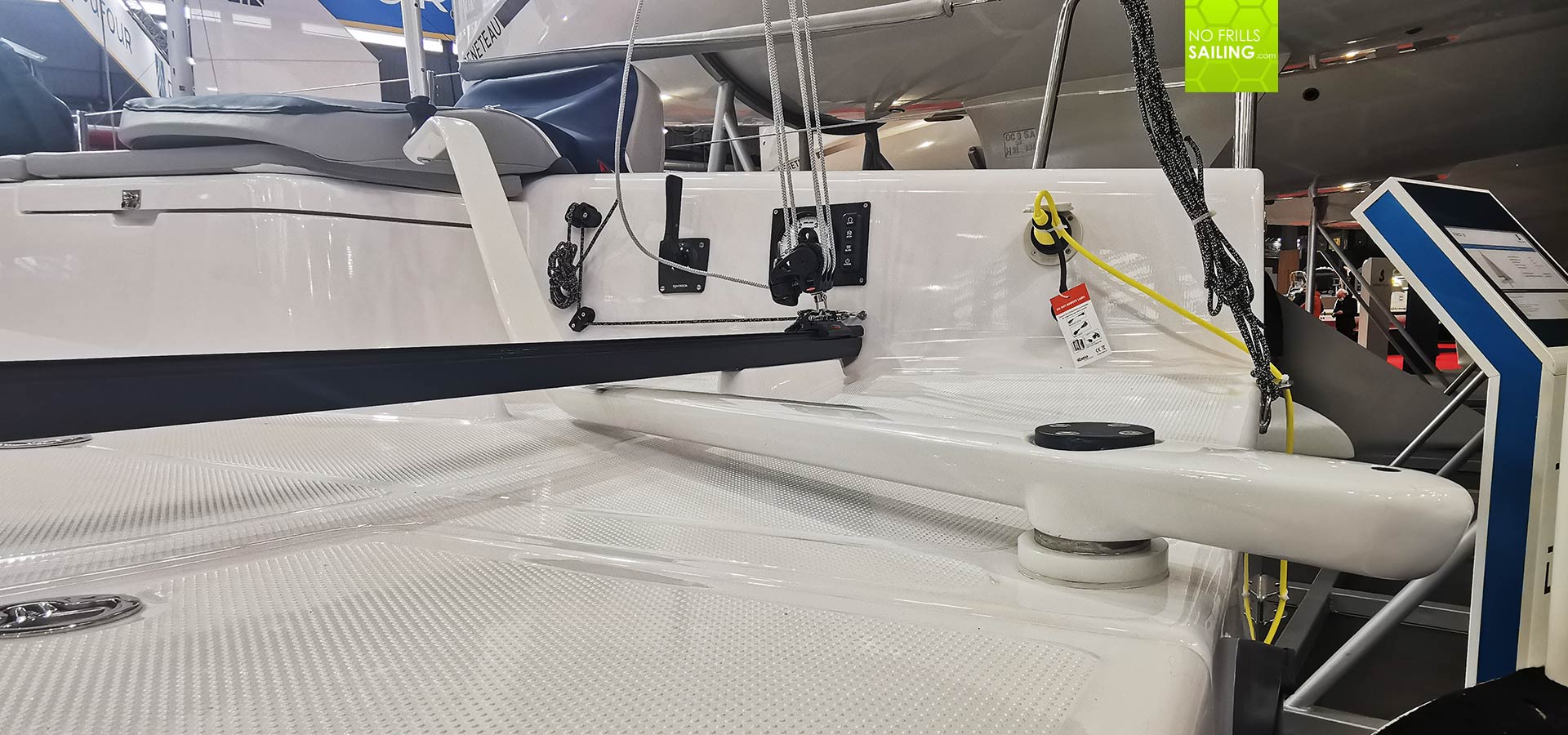
Steering is the same, the First 27 of course has not the carbon tiller but a composite GRP-tiller that will serve well. Double rudder configuration and steering mechanism is the same as on the First 27 SE. There are changes though with mainsheet-layout in the new 27. As you may see, the mainsheet “ends” on a curry clamp directly on the mainsheet traveler car. That frees the cockpit from the rope salad, especially the forward part where the guests or family will be residing.

I haven´t sailed her yet and in this it is an open question whether a central attachment point for the mainsheet as in 27 SE is more practical, but on first sight I can see the point in putting this aft: The First 27 is intended to improve cruising capabilities and comforts and a line-covered cockpit may be cool when sailing alone or in race mode but can be annoying and unsafe when travelling with family or non-sailors.
Very practical, but …
Another main difference is the inboard Diesel engine of the new First 27. That said, they have incorporated the 15 horse power Yanmar Diesel engine. Assuming a 3 liter per hour consumption that is an 8 hours-running time, 5 knots average speed would be a range of some 50 to 60 nautical miles. That is a plus over the all-electric propulsion I use on my First 27 SE as my Torqeedo battery (WH 48-5000) grants a max 50 nautical mile range with a speed of just 3 to 3.5 knots over ground. Also, you can easily have a canister of 15 or even 20 liters of Diesel spare with you aboard to double the range – no chance for that with e-Power.

The engine is started and run using the same display/control panel and throttle-lever as known from bigger boats so that there will be no adaption for sailors. Just push the engine-button and the internal combustion will spring to life. The Diesel tank is situated right underneath the cockpit floor (I assume right behind the engine) and is filled via small filler in the middle of the floor at the aft part of the boat.

The Diesel engine will put her power on a fixed shaft. This one is connected to a Gori folding prop with two blades. I´ve checked this setup by crawling underneath the boat´s hull. Surely, this setup increases comfort manyfold over the SE-version: No sliding and turning out the propulsion unit (either Tohatsu outboard engine or Torqeedo electric), no water “inside” the boat coming in through the engine trunk and no hustle, just push-button and away we go. On the other side …
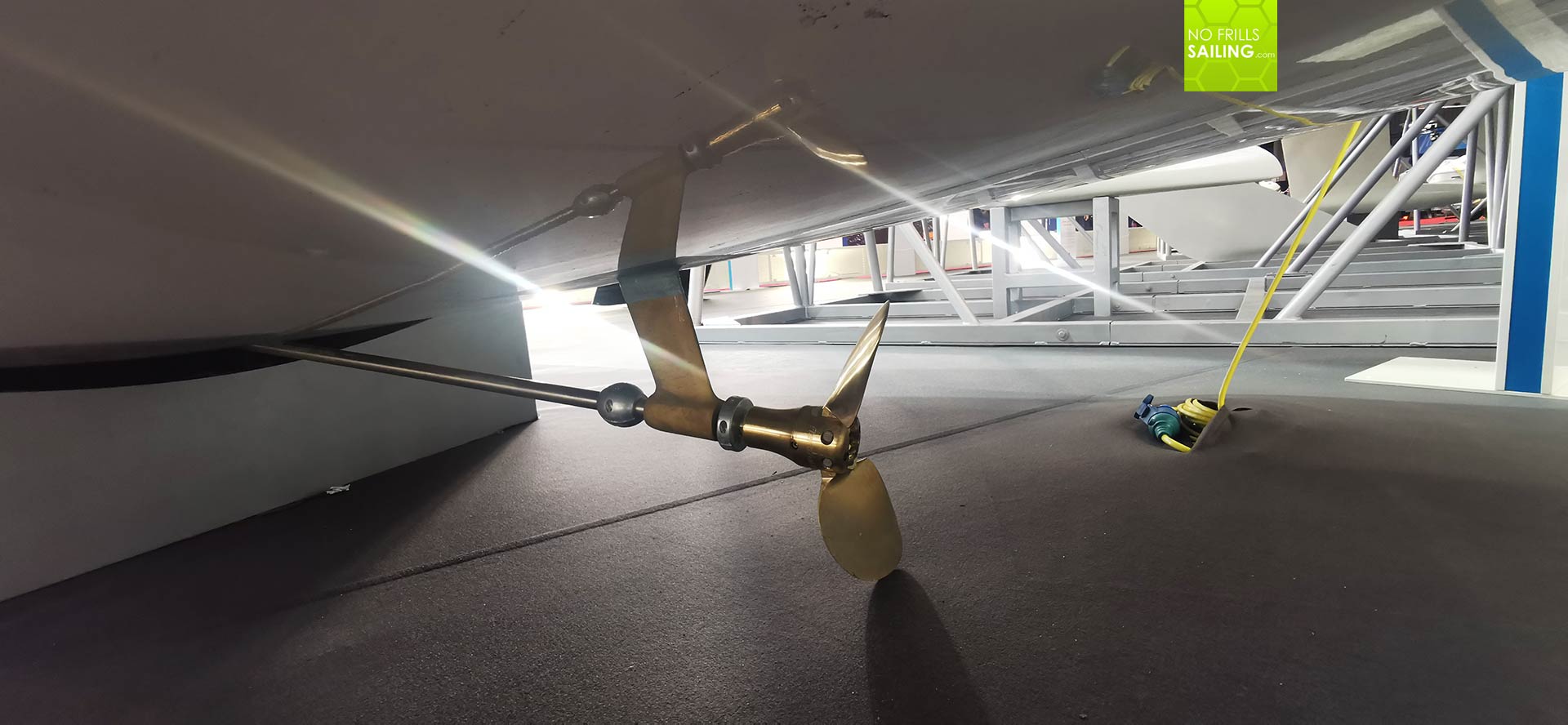
Well, I am sure that one of the reasons why the 27 SE is sailing so superbly well is that there is no obstruction of hydrodynamic flow other than keel and rudder blades. Meaning, no shaft and no screw in the way. I don´t have the numbers for how much drag the shaft/blade-configuration creates but I am sure that´s plenty of. Comfort always comes with a price tag and in this respect the engine, fixed shaft and the prop not only make for a significant increase in weight but also increase resistance of the hull going through the water. Combined with less sails area the equation is clear: Less performance over the SE. But, as said, that was the plan from the onset. Prime focus on comfort.
Huge improvement for cruising sailors: Cockpit
And here´s the biggest of these improvements and I shall say I really loved it: The new cockpit! At first, just looking at the renderings and sketches, I thought this looked quite improvised and kind of unmotivated, but, again, I must say that the implementation of the idea to improve comforts in the cockpit has been done A+ grade, really, good job!

The boat comes with two seating benches right next to the entryway down. They are wide enough to offer a comfortable seating space, in fact, there is no different to the benches on bigger boats, except that of course the First 27 has no coamings and thus no backrest to lean onto when sitting facing the cockpit table. (Speaking of which: There is now the possibility to fit one into the First 27 cockpit, no chance for the 27 SE though). But back to the seating benches. You can sit there and have a breakfast in your cockpit and recline there – one of my favourite positions when “standing” my watch – with feet facing the aft end. The cabin superstructure make for a perfect backrest.
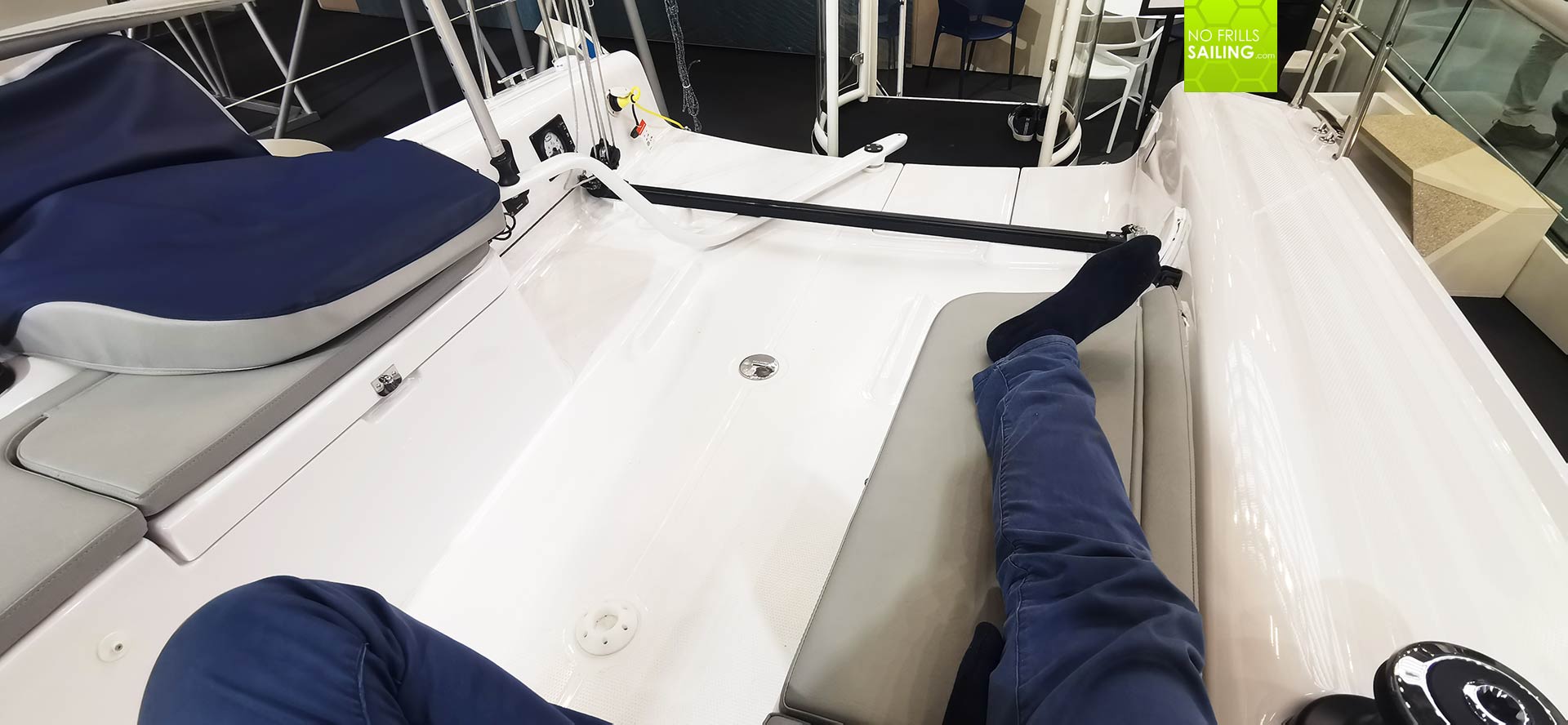
It is totally comfortable. When sailing upwind or with significant heeling there might be a problem with having no coamings to wedge yourself into, but in smooth cruising mode this will become a welcome position to spend your time in. The option list of course include cushions which are safely attached to the benches. One might not choose the magnetic compass (I as well didn´t for my 27 SE) because that one will hurt your back when leaning onto it.
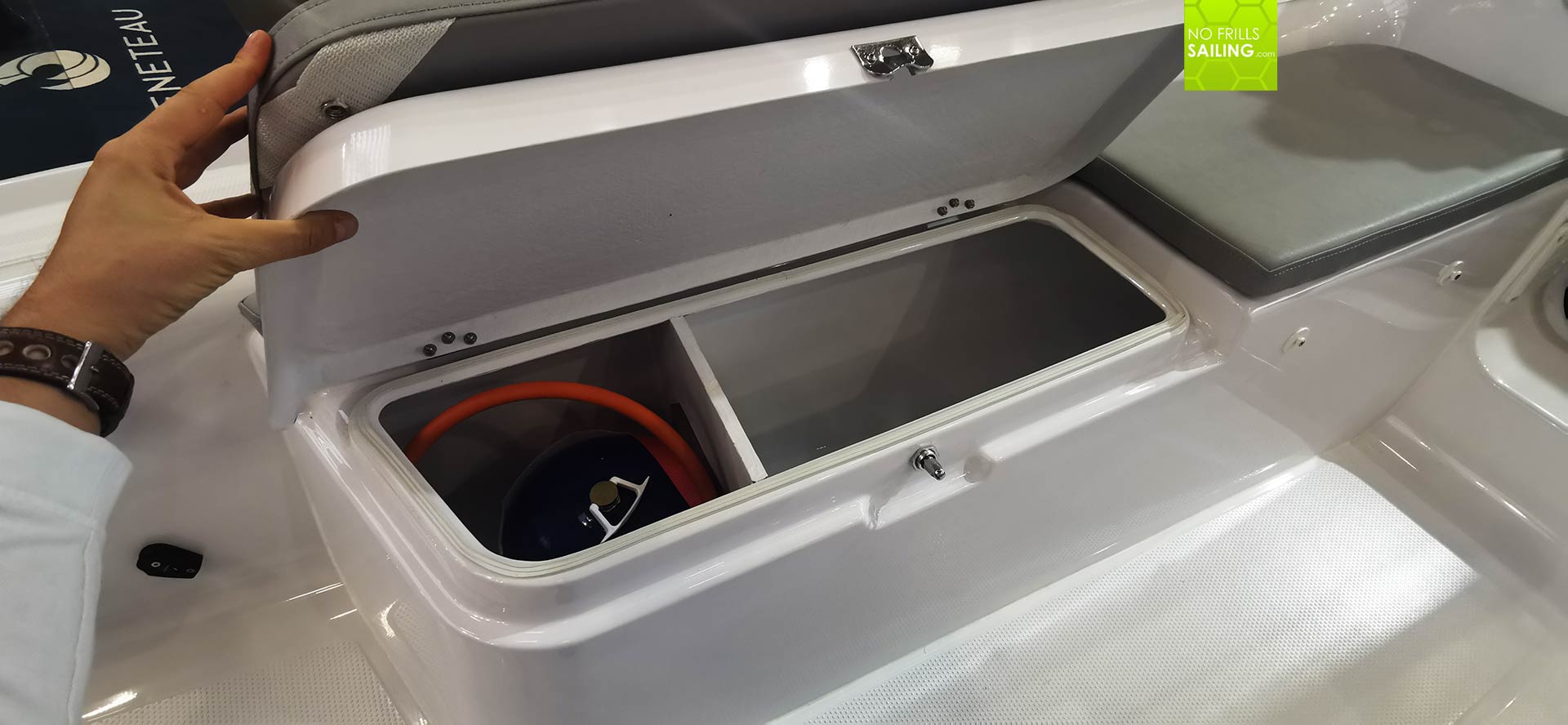
The benches come with closing flaps and underneath the whole volume may be utilized for stowing away fenders and lines, the above mentioned Diesel-canister or safety equipment. Very practical indeed as I, for example, have to put my fenders down into the salon, blocking one way around the salon table. Port side bench includes the Propane gas stowage for the galley (if opted in) and of course the hatches can be secured with a lock. All in all, this is in my view the most important and most valuable contribution to increasing comforts, together with “fire and forget” inboard Diesel engine.
So far, so (very) good!
Now, with having spent nearly one hour peaking into every corner and lurking behind all flaps and hatches, strolling around the hull, taking a seat here and there and imagining myself sailing her, what would be my verdict? “Well done, Seascape and Beneteau!”, I would say at first. I absolutely have to revise my first statements of the “Alu-Firsts” being just a strategic stunt to create more sales. Well, in essence, it has been conceived to create more sales, of course, but it is far from being a “cheap First”. That clearly is not the case!
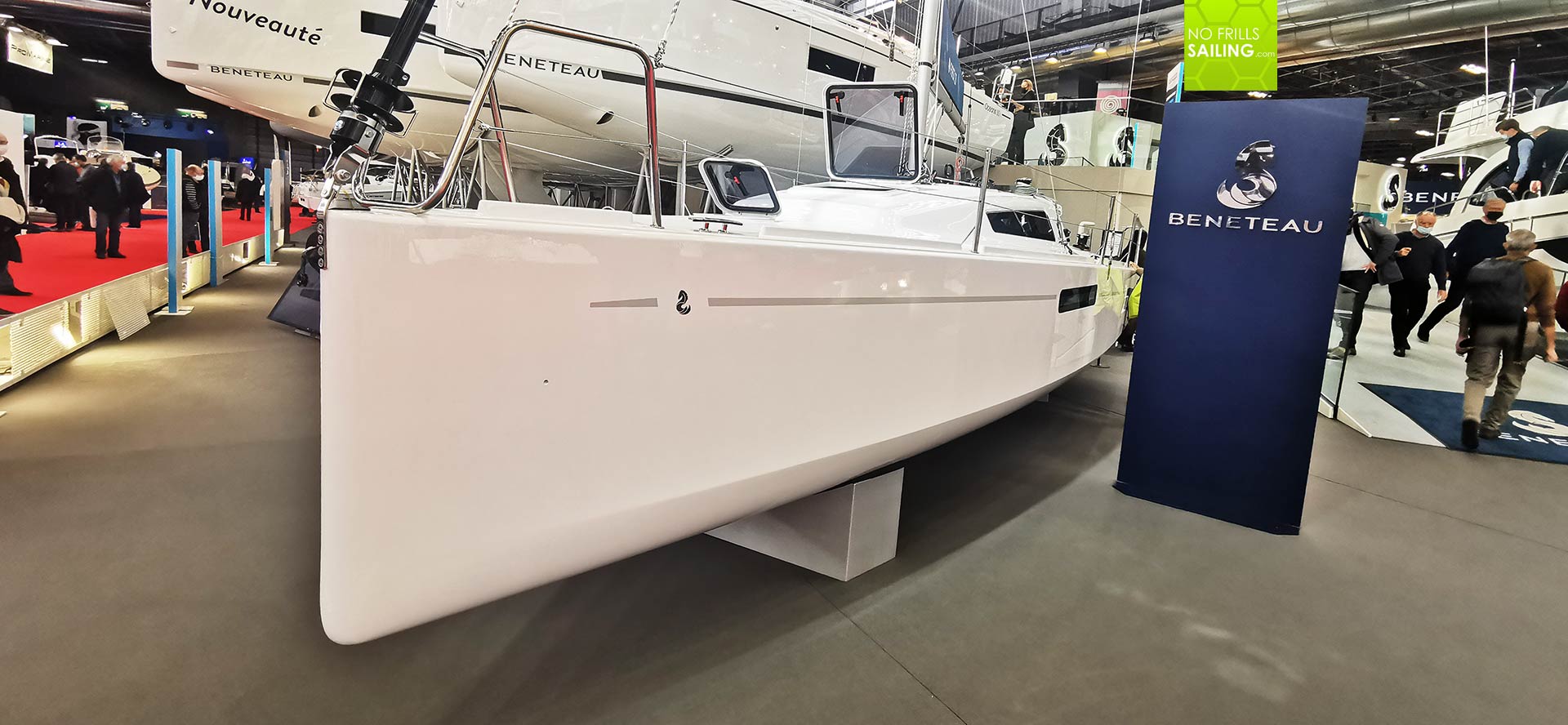
The changes made look decent and logical. The inboard propulsion increases easiness of usage, maintenance and “plug-and-play”-fun enormously. I know it for real as many, many potential clients I talk to about the 27 are a kind “afraid” or reluctant of the fold-out-technique in the 27 SE. Also, the aluminium rigging and a bit eased sailing power, combined with easier handling, back stay and less pressure in the system will make this new boat much more appealing to “normal” sailors, young families or people seeking a small boat with some comforts and – still much! – sailing capabilities.

Well, regarding these, I still haven´t sailed the First 27 to being able to come up with a real-world-verdict. But we have a 27 underway that will be ready and in the water by spring 2022. I am planning to take her to a promo-tour through Baltic Sea and Lake of Constance again, like I have done with the First 24 SE last year, and latest within the coming 4 to 6 months I will publish an article directly comparing the sailing performance, real data and the comparison of the two boats sailing-wise. So something to look forward to … Nevertheless, my impression left from Paris is a very, very positive one on this whole new boat, which happens to being called First 27.
You may also be interested in reading these articles connected with First 27 or Seascape:
A Slovenian startup (and much more …)
Receiving my First 27 SE
From subtle to hard – maiden voyage of my First 27 SE
